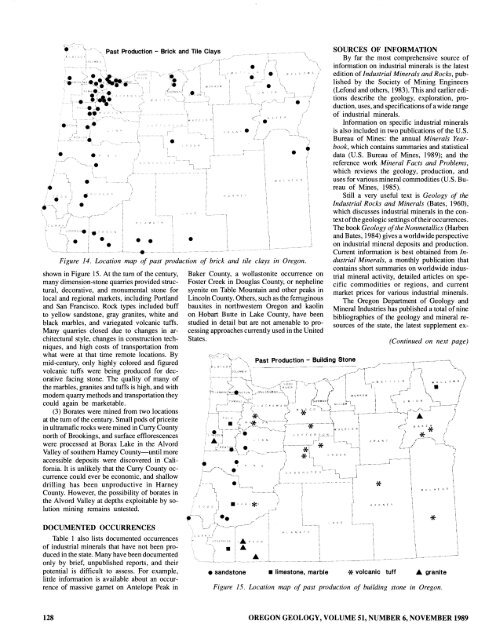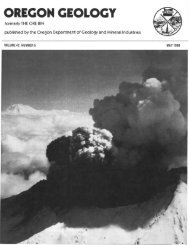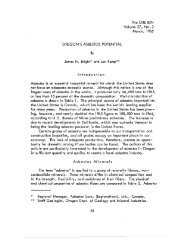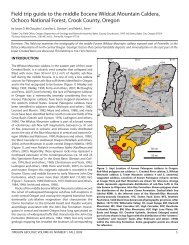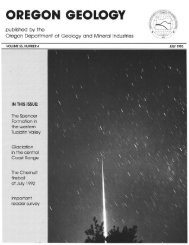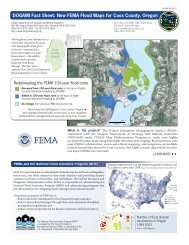Ore Bin / Oregon Geology magazine / journal - Oregon Department ...
Ore Bin / Oregon Geology magazine / journal - Oregon Department ...
Ore Bin / Oregon Geology magazine / journal - Oregon Department ...
Create successful ePaper yourself
Turn your PDF publications into a flip-book with our unique Google optimized e-Paper software.
•<br />
• • •<br />
• •<br />
i<br />
•<br />
;'<br />
~ Past Production - Brick and Tile Clays SOURCES OF INFORMATION<br />
• •<br />
• • •<br />
--e---<br />
Figure 14. Location map of past production of brick and rile clays in <strong>Ore</strong>gon.<br />
shown in Figure 15. At the tum of the century,<br />
many dimension-stone quarries provided structural,<br />
decorative, and monumental stone for<br />
local and regional markets, including Portland<br />
and San Francisco. Rock types included buff<br />
to yellow sandstone, gray granites, white and<br />
black marbles, and variegated volcanic tuffs.<br />
Many quarries closed due to changes in architectural<br />
style, changes in construction techniques,<br />
and high costs of transportation from<br />
what were at that time remote locations. By<br />
mid-century, only highly colored and figured<br />
volcanic tuffs were being produced for decorative<br />
facing stone. The quality of many of<br />
the marbles, granites and tuffs is high, and with<br />
modem quarry methods and transportation they<br />
could again be marketable.<br />
(3) Borates were mined from two locations<br />
at the tum of the century. Small pods of priceite<br />
in ultramafic rocks were mined in Curry County<br />
north of Brookings, and surface efflorescences<br />
were processed at Borax Lake in the Alvord<br />
Valley of southern Hamey County-until more<br />
accessible deposits were discovered in California.<br />
It is unlikely that the Curry County occurrence<br />
could ever be economic, and shallow<br />
drilling has been unproductive in Harney<br />
County. However, the possibility of borates in<br />
the Alvord Valley at depths exploitable by solution<br />
mining remains untested.<br />
DOCUMENTED OCCURRENCES<br />
Table 1 also lists documented occurrences<br />
of industrial minerals that have not been produced<br />
in the state. Many have been documented<br />
only by brief, unpublished reports, and their<br />
potential is difficult to assess. For example,<br />
little information is available about an occurrence<br />
of massive garnet on Antelope Peak in<br />
Baker County, a wollastonite occurrence on<br />
Foster Creek in Douglas County, or nepheline<br />
syenite on Table Mountain and other peaks in<br />
Lincoln County. Others, such as the ferruginous<br />
bauxites in northwestern <strong>Ore</strong>gon and kaolin<br />
on Hobart Butte in Lake County, have been<br />
studied in detail but are not amenable to processing<br />
approaches currently used in the United<br />
States.<br />
,<br />
•<br />
Past Production - Building Stone<br />
By far the most comprehensive source of<br />
information on industrial minerals is the latest<br />
edition of Industrial Minerals and Rocks, published<br />
by the Society of Mining Engineers<br />
(Lefond and others, 1983). This and earlier editions<br />
describe the geology, exploration, production,<br />
uses, and specifications of a wide range<br />
of industrial minerals.<br />
Information on specific industrial minerals<br />
is also included in two publications of the U.S.<br />
Bureau of Mines: the annual Minerals Yearbook,<br />
which contains summaries and statistical<br />
!<br />
data (U.S. Bureau of Mines, 1989); and the<br />
reference work Mineral Facts and Problems,<br />
which reviews the geology, production, and<br />
uses for various mineral commodities (U.S. Bureau<br />
of Mines, 1985).<br />
Still a very useful text is <strong>Geology</strong> of the<br />
Industrial Rocks and Minerals (Bates, 1960),<br />
which discusses industrial minerals in the context<br />
of the geologic settings of their occurrences.<br />
The book <strong>Geology</strong> of the Nonmetallics (Harben<br />
and Bates, 1984) gives a worldwide perspective<br />
on industrial mineral deposits and production.<br />
Current information is best obtained from Industrial<br />
Minerals, a monthly publication that<br />
contains short summaries on worldwide industrial<br />
mineral activity, detailed articles on specific<br />
commodities or regions, and current<br />
market prices for various industrial minerals.<br />
The <strong>Ore</strong>gon <strong>Department</strong> of <strong>Geology</strong> and<br />
Mineral Industries has published a total of nine<br />
bibliographies of the geology and mineral resources<br />
of the state, the latest supplement ex-<br />
(Continued on next page)<br />
• sandstone • limestone, marble * volcanic tuff • granite<br />
Figure 15. Location map of past production of building stone in <strong>Ore</strong>gon.<br />
*<br />
128<br />
OREGON GEOLOGY, VOLUME 51, NUMBER 6, NOVEMBER 1989


